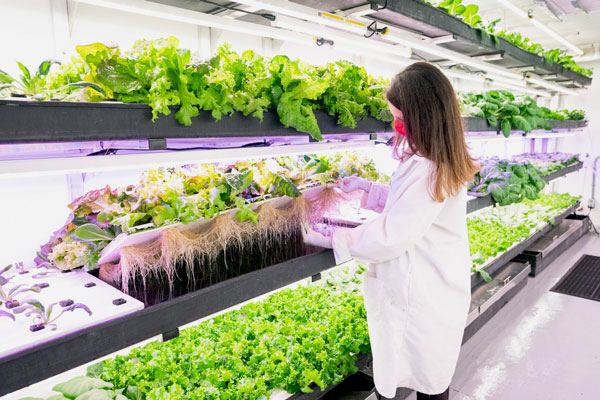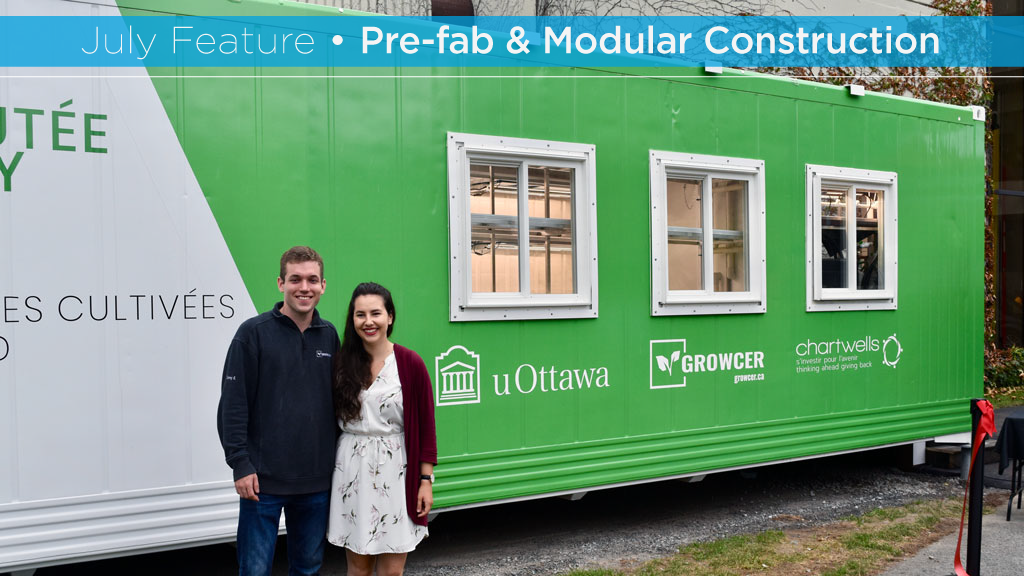Imagine living in a large multi-unit residential building (MURB) and picking up a box of vegetables from the modular farm in-house when you need something for dinner. That’s just one of the scenarios that Growcer co-founder Corey Ellis foresees for future building design.
Growcer manufactures hydropontic modular farms in its facility in Manitoba just outside Winnipeg. These modular units have become integrated in more than 70 instituations, commercial outlets, co-ops and First Nations operations across Canada.
“We are currently talking to a developer (in Eastern Canada),” he said as the large MURB complex offers the opportunity to tie the food chain supply closer to the user.
The pandemic showcased the supply difficulties that can occur and provided the architectural community with with the opportunity to rethink green roofs that grow plants for farm modules that supply in-house produce.
The latest Growcer modular farm arrived by truck in mid-July to Saskatchewan’s Yorkton Legacy Co-op, where the 10-by-10-by-42-foot unit will start growing leafy greens year-round for co-op members.
The $300,000 units come ready to install, are craned off a truck and rely on electrical and plumbing trades locally for final hook-up.
“I think there are a few different reasons for doing this,” said general manager Harley McClughan, speaking of the move to get grow-connected. “There is food security but there is also environmental impact as you are not transporting product.”
McClughan said Legacy is not the first co-op to acquire a modular farm, which sits behind the co-op building. He knows of others, especially in northern regions, where they are popular.
As well as allowing the co-op to produce food year-round, the co-op can also market its own house brands. The insulated units, which use grow lights, can grow 140 different leafy greens on a six- to eight-week rotation. Other co-ops that use the module farms include Arctic co-op, Yellowknife co-op, and Grand Prairie, Alta.’s New Horizon Co-op.
First Nations organizations have been fast adapters of the units.
In B.C., the Squamish Nation uses a modular farm to supply fresh greens to nation families and its family services programs such as its youth centre, community kitchen and pantry.
Institutes such as Acadia University (through Chartwell) and the University of Ottawa (uOttawa) utilize units in their food prep services, but they can also serve as a teaching guide for individuals in the agricultural programs.
The modular units are only just breaking into a broader market, according to Ellis. They can be used as rooftop installations on hotels, large scale housing developments, hospitals or any facility where a large number of individuals need to be fed.

“This is not something you would put in your backyard,” he said, adding it produces 700 vegetables a week.
Growcer co-founders Ellis and Alida Burke started the concept in 2016 while they were students at uOttawa. They had travelled to Iqaluit, Nunavut as part of Enactus uOttawa, a student club focused on social entrepreneurship, and were shocked at the cost of groceries in northern areas and the complex issue of getting food to these areas. For example, some areas have food flown in but when bad weather hits, planes cannot fly.
The pair came up with the concept of a plug-and-play hydroponic farm capable of yielding 8,500 pounds of fresh produce in temperatures as cold as -40 C. The custom built modular structures can be shipped onsite via truck, rail or marine cargo.
In 2018, they appeared on the Dragons’ Den and won funding but as Ellis said, the couple, while appreciative, decided that too much too soon might not be the best solution.
They declined the funds and focused on controlled growth in a new market. Shortly before the pandemic, in 2020, they opted out of converting shipping containers into manufacturing their own designed modules.
They found building a modular farm was more efficient as the units use structural insulated panels providing better insulation values than found in shipping containers and adapting the containers eroded growing area.
The modular manufactured units with insulated panels provided for a 28.5 R-value and more temperature control. Shipping containers also had a lifespan of 25 years, while Growcer wanted its own design (with a slanted roof to shed snow) to have a longer 30-year life span.
As well, the company moved from a nutrient feed system that saw water pumped across roots to its current deepwater culture (DWC) system where plants sit on a raft and roots feed into the water. The DWC is more forgiving if power disruptions occur as the other system relies upon a pump to deliver nutrients to the growing roots.
Ellis said the units utilize grow lights but those same lights also emit heat and will sustain the unit to a temperature outside of -25C.
“There is a small heater in the unit for supplementary heat,” he said, but in most cases the grow lights are enough.
Ellis said the lights can generate too much heat and the company is looking at pairing the units with regular greenhouse operations into which heat can be transferred.
With the units proven out in the market, Ellis said he is now experimenting with a system that can be used to grow fruits such as strawberries.






Recent Comments